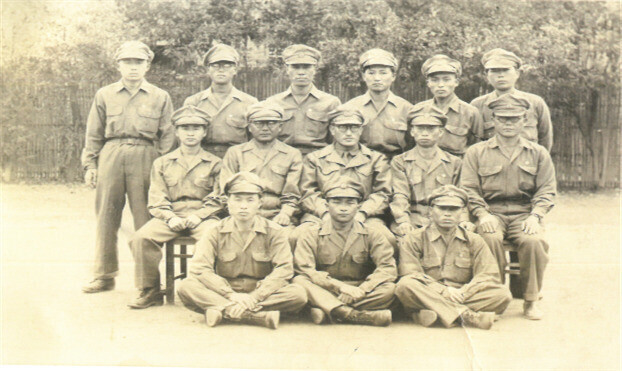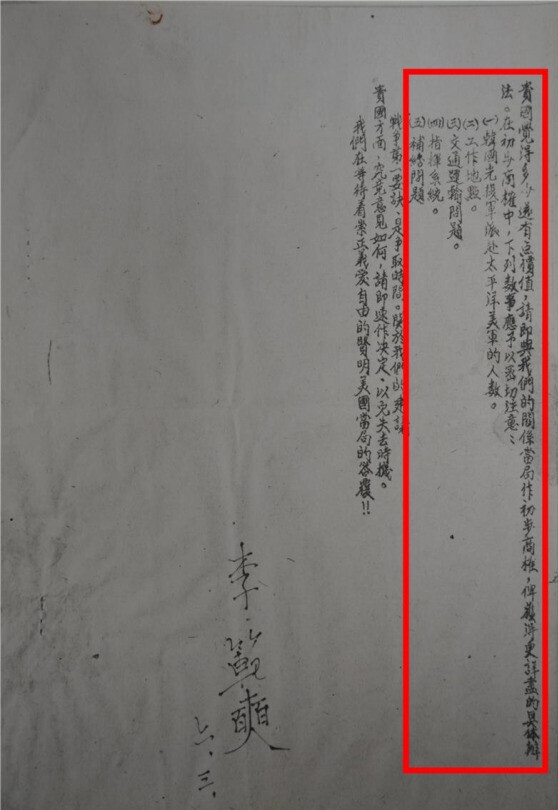
Korean Liberation Army Chief of Staff Lee Beom-seok (second row, center) and other members of the KLA's 2nd Company. (provided by the Ministry of Patriots and Veterans Affairs)
South Korea’s Ministry of Patriots and Veterans Affairs announced Tuesday that it had uncovered the first official proposal for a military coalition between Korea and the US that was drafted during World War II by the Korean Liberation Army (KLA), the army of the Korean Provisional Government.
The document takes the form of a 10-page report composed on June 3, 1942, by KLA Chief of Staff Lee Beom-seok with the intent of sending it to the US federal government. It vividly illustrates how the KLA aggressively sought to reach out to the US and join forces with it after fighting began in the Pacific theater.
The document in question describes in detail the necessity of Korean independence, the KLA’s mission, the role the KLA could play in the Pacific theater of the war, and what matters would need to be negotiated with the US.
“This document is of great significance since it’s an official document produced by the Korean Liberation Army that shows the army’s initial attempt to make diplomatic contact with the US and offer to take part in the war,” the Ministry of Patriots and Veterans Affairs explained.
The document states that the KLA, as the military arm of the Provisional Government of the Republic of Korea, would “form the basis of the national army of Korea following the future establishment of an independent state.”
“The KLA’s mission is to achieve not only Korean independence but also peace for humanity alongside the Allies,” it reads.
One revelation in the document is the concrete proposal it makes for a military coalition with the US. “The KLA will deploy its forces in the Pacific War and with American aid will form Korean guerilla units in China that can roil the Japanese army at its rear.”
The document mentions specific aspects of carrying out the war that the KLA needed to negotiate with the US including “the size of the deployment, the place of operations, transportation and logistics, chain of command, and the issue of supply,” showing how seriously the KLA had explored forging a military coalition with the US in World War II.

In the document, shown in part here, Lee Beom-seok listed the items that Korea needed to negotiate with the US including “the size of the deployment, the place of operations, transportation and logistics, chain of command, and the issue of supply.” (provided by the Ministry of Patriots and Veterans Affairs)
“This document shows specifically that figures in the Korean Provisional Government, the Korean Liberation Army and the Korean Commission in the US tried to set up a military coalition with the US during the war in the Pacific,” said Jung Byung-joon, a professor of contemporary Korean history at Ewha Womans University.
“This is a rare document, the first of its kind to be discovered in Korea or elsewhere. It is therefore of great historical significance,” said Kim Gwang-jae, a researcher with the National Institute of Korean History who researches the KLA.“We plan to analyze the papers of George McAfee McCune, which contain a detailed record of the activities of the US Office of Strategic Services, to identify more Koreans who contributed to the cause of independence. Moving forward, we will release more documents related to the independence movement that remain unknown in Korea,” the Ministry of Patriots and Veterans Affairs said.This document was one of many donated by George McAfee McCune to the Center for Korean Studies at the University of Hawai’i. It was uncovered by the ministry last December as part of a project to collect records about the independence movement outside of Korea.George McAfee McCune was the son of George Shannon McCune, an American missionary and freedom fighter who was awarded the Order of Merit for National Foundation, Independent Medal, in 1963. The younger McCune came to possess documents related to the Korean independence movement while serving as a Korean expert at the US Office of Strategic Services and the State Department during World War II.By Kwon Hyuk-chul, staff reporter
Please direct questions or comments to [
english@hani.co.kr]


No comments:
Post a Comment